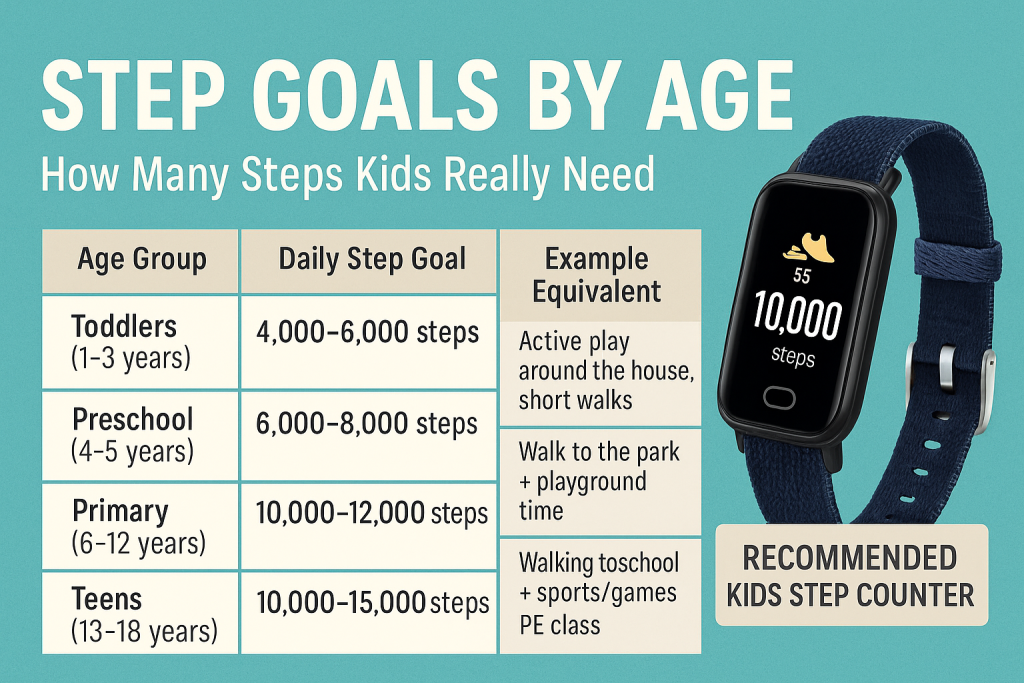Why Step Counts Matter for Kids
Walking isn’t just about movement — it’s one of the easiest ways for children to stay active, build strength, and support their overall development.
Daily step goals can help kids:
- Strengthen bones and muscles
- Improve cardiovascular health
- Maintain a healthy weight
- Boost mood, confidence, and focus
- Build lifelong healthy habits
While running, climbing, and cycling all count toward activity, step counts are a simple way to track overall movement.
Quick Reference — Recommended Daily Steps for Kids
| Age Group | Daily Step Goal | Example Equivalent |
|---|---|---|
| Toddlers (1–3 years) | 4,000–6,000 steps | Active play around the house, short walks |
| Preschool (4–5 years) | 6,000–8,000 steps | Walk to the park + playground time |
| Primary (6–12 years) | 10,000–12,000 steps | Walking to school + sports/games |
| Teens (13–18 years) | 10,000–15,000 steps | PE class + sports practice |
Note: These are average recommendations. Some active children will naturally exceed these numbers.
Step Goals by Age — A Closer Look
Toddlers (1–3 years)
- Goal: 4,000–6,000 steps
- How to achieve: Encourage active play, crawling, dancing, and short outdoor walks.
- Tip: Keep it fun — toddlers don’t need “formal” exercise, just opportunities to move.
Preschoolers (4–5 years)
- Goal: 6,000–8,000 steps
- How to achieve: A trip to the park, running in the garden, or a short family walk after dinner.
- Tip: Mix walking with imaginative play (pretend adventures, treasure hunts).
Primary School Children (6–12 years)
- Goal: 10,000–12,000 steps
- How to achieve: Walking to school, playing football, joining after‑school clubs, or family weekend walks.
- Tip: Give them mini challenges, like “Let’s see if we can do 1,000 more steps before dinner.”
Teenagers (13–18 years)
- Goal: 10,000–15,000 steps
- How to achieve: PE classes, sports training, weekend hikes, or walking with friends.
- Tip: Involve them in planning active outings so it feels like their choice.
Fun Ways to Boost Daily Steps
- Walking Challenges – Create family step goals and track them together.
- Park Adventures – Visit different playgrounds or nature trails each week.
- Dance Breaks – Put on music and have a quick family dance session.
- School Run Walks – Swap short car trips for walking where possible.
Recommended Kids Step Counter
A step counter can make reaching daily step goals more exciting for children. They’ll love checking their progress and challenging themselves to beat yesterday’s total.
BIGGERFIVE Kids Fitness Tracker

- Tracks steps, distance, and calories burned
- Waterproof design – great for active kids
- Long battery life – up to 7 days per charge
- Comfortable nylon strap – adjustable for all wrist sizes
- Fun and motivating – kids love checking their progress
Price: Varies — Check on Amazon UK »
We recommend the Biggerfive because it is simple and budget friendly. If your looking for something with extra bells and whistles check out our Top 5 Fitness Trackers For Kids
Official Guidelines for Kids’ Physical Activity
According to NHS guidelines, children and young people aged 5–18 should aim for an average of at least 60 minutes of moderate to vigorous physical activity every day. This can include brisk walking, cycling, active play, and organised sports.
The World Health Organization (WHO) also recommends limiting long periods of sitting and encouraging active play throughout the day for younger children.
Why Steps Aren’t the Only Measure of Activity
While step counts are a great way to track movement, they don’t capture every type of physical activity. Activities such as cycling, swimming, gymnastics, and certain team sports may not register as steps but still contribute to your child’s overall health and fitness.
The key is to encourage a variety of activities that keep your child moving and having fun, whether or not they count towards a daily step goal.
Motivation Tips and Fun Rewards
- Sticker charts – Let kids add a sticker for each day they reach their goal. This pack of 40 incentive sticker charts on Amazon is perfect.
- Family step challenges – See who can get the most steps in a week.
- Weekend rewards – If they hit their goal all week, let them choose a family activity.
- Personal bests – Encourage them to beat their own records rather than comparing with others.
Common Mistakes to Avoid
- Focusing too much on the exact number instead of overall activity.
- Comparing children with different ages, sizes, or fitness levels.
- Forgetting that some activities won’t register as steps but are still beneficial.
- Not making movement fun – kids stay active longer when they enjoy it.
Looking for more ways to keep your kids active? Check out our Fitness tips for creative ideas that get them moving.
FAQ — Step Goals for Kids
Q: Is 10,000 steps too much for a child?
A: Not usually — for most school‑age kids, 10,000 steps is healthy and achievable through normal play and school activities.
Q: What if my child can’t reach their step goal?
A: Focus on progress, not perfection. Small increases in activity each week still bring big health benefits.
Q: How do steps compare to minutes of exercise?
A: Roughly 1,000–1,200 steps equals about 10 minutes of moderate walking.
Key Takeaway
Daily steps are a simple, effective way to help kids stay active. Whether they’re chasing bubbles in the garden, walking to school, or hitting their step counter goal, every step counts toward a healthier, happier childhood.

